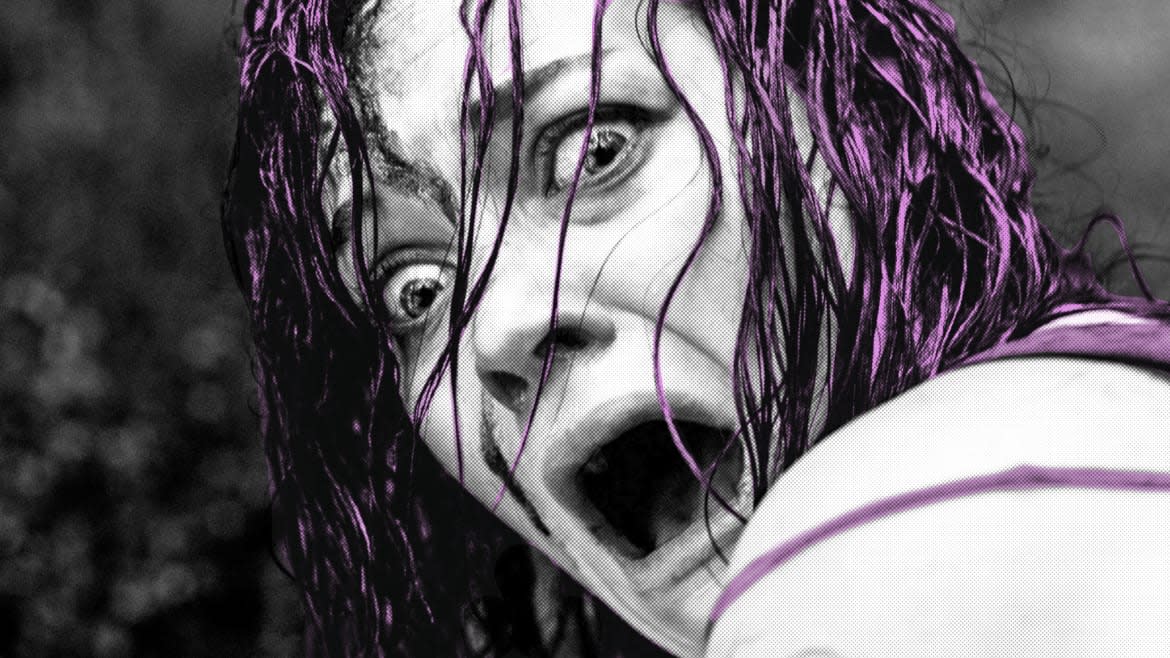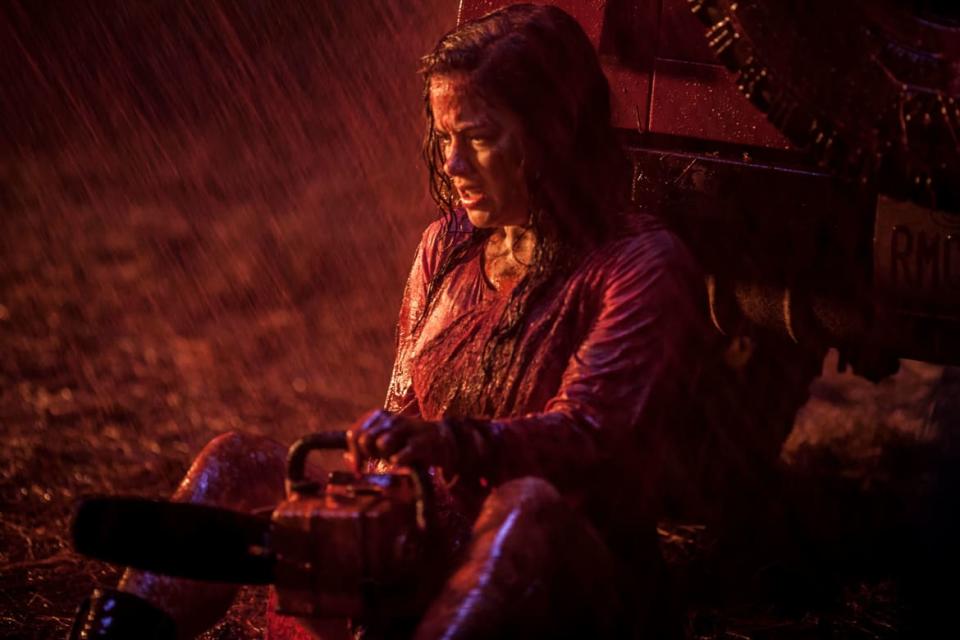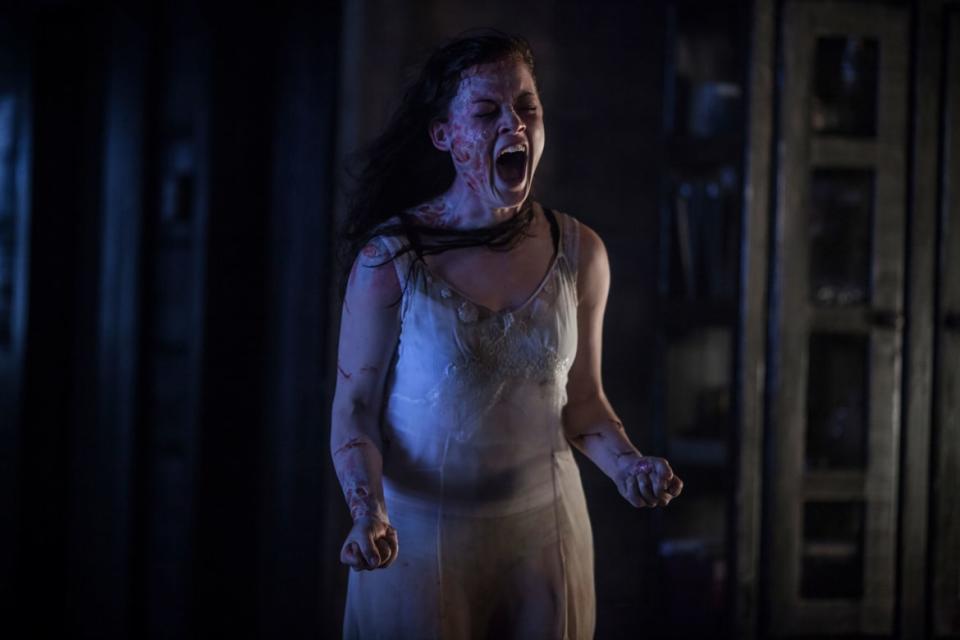10 Years On, ‘The Evil Dead’ Reboot Has Become a Must-See

- Oops!Something went wrong.Please try again later.
- Oops!Something went wrong.Please try again later.
- Oops!Something went wrong.Please try again later.
Always with the cabin, these kids. The woods. The evil book. The geysers of blood. The Evil Dead movies have the feel of a dark ritual, some sort of rite taking place on celluloid every couple of years, not so much rebooted as reanimated. Director Sam Raimi first headed to the woods to perform the story as a 32-minute short in 1978, before scraping together enough financing to do it again at a feature-length 85 minutes in 1981. The production was legendarily brutal; crew members slept in the derelict cabin and burned furniture to keep warm at night. Wounds were commonplace, to Raimi’s malevolent delight.
The resulting movie contained something primal and unhinged: a camera unmoored from convention, Bruce Campbell’s frankly NSFW chin, and a gory climax with so much viscera, it appears to—and in fact does—contain creamed corn.
Bruce Campbell on the Tragedy of ‘Ash vs Evil Dead’: ‘We’re Not Star Wars’
Stephen King raved about the movie so much after seeing at the Cannes Film Festival that it eventually got distribution, becoming a hit for New Line Cinema. In 1987, Raimi got a chance to do it all a third time. Ostensibly a sequel, Evil Dead II follows an identical plot: again with the cabin, the kids, the woods, the evil book unearthed from the basement — but this time inflamed with Three Stooges-style physical comedy, grotesque puppetry and stop-motion effects, and an extremely ’80s thirst for high fantasy. And it all, again, happened in under 90 minutes.
A few years later Raimi and team continued the trilogy, shedding the cabin and most of the horror elements in 1991’s Army Of Darkness. It’s my least favorite in the series; I’ll always prefer the first installment, which feels like what a 30-pack of Coors Original would turn into if it could turn into a movie. But that’s almost beside the point. Raimi’s Evil Dead trilogy remains one of those legendary series, in which every installment is held in top regard by someone.
That changed when a new director, Fede Alvarez, took the story into the woods a fourth time in 2013. Raimi had attempted to mount a fourth installment for years, and the preceding decade had been a remarkably good time to reboot a horror series, preferably while making it as gritty as possible. Starting with 2003’s Texas Chainsaw Massacre remake, practically every major horror movie of the late-20th century got a fresh coat of Platinum Dunes-style lacquer: Dawn of the Dead, The Amityville Horror, The Omen, Friday The 13th, A Nightmare On Elm Street; even one-offs like Fright Night and Prom Night and The Wicker Man made returns.
Fright Night’s Marti Noxon on 'Shaun of the Dead,' 'Evil Dead II,' 'Ghostbusters,' More
Critics savaged these movies, for the most part, although several have enjoyed a critical reevaluation in recent years. Among those newly appreciated entires include that Elm Street remake and Rob Zombie’s Halloween movies from 2007 and 2009, which wield a snuff-film intensity toward surprisingly character-driven ends.
Yet in 2013, it was surprising that the Evil Dead remake worked pretty well. It was the sort of response you got texted by a like-minded horror fan. Like so many of these post-millennial horror movies, the remake trades the live-wire energy of its classic-horror inspiration for a strengthened personal-trauma angle.
Where Freddie’s pedophilic undercurrent was made explicit in the Elm Street remake, and Michael Myers’ childhood traumas were detailed for an hour in Zombie’s Halloween, the new Evil Dead gave the kids something to do in the woods besides party. The opposite, in fact: New protagonist Mia (Jane Levy) received support from her brother and a couple of friends, as she sobered up cold-turkey from some unspecified drug addiction. The camera watches from deep in the Earth, as she empties out a plastic baggy into a well. But what was it looking up at her?

Well, you know what movie we’re talking about here. Within minutes, the book is uncovered, and the shit is headed fan-ward. Alvarez yokes together the addiction-recovery and awoken-evil narratives only lightly, and to good effect. Mia’s personal arc provides an emotional hook to the story that Raimi’s more sensory aims did not require. As we hit the familiar narrative beats—the basement, the book, the invocation of the words—Mia convulses, turns sour, makes a break for it, and crashes the car the group drove there in, all ostensibly in throes of withdrawal. (This section also attempts to subvert the original’s worst scene by turning a pagan assault into a metaphor for addiction.)
This somber setup does not mean that the movie is drained of all the series’ trademark humor, although it’s of a particularly mordant variety. After a shocking cold open, the film’s title erupts onto the screen with a comically evil sting; a foreboding image of a chainsaw immediately cuts to a woman placidly slicing roast beef; Mia’s family dog has the awesome name of Grandpa.
You know you have left the “occasional mordant humor” portion of the movie when Grandpa is found beaten to death with a hammer. Act two is as intense as “drug withdrawal crossed with demonic possession in the woods” would suggest. Alvarez, like Raimi before him, keeps things relentlessly present-tense, toying with horror-movie convention. The familiar “closing the bathroom mirror” jump-scare occurs here gradually, such that we watch the new reflection creep into view.

One of Raimi’s favorite tricks was to have a possessed person suddenly revert to their old self, and Alvarez wrenches this for all it’s worth, having one character sweetly ask why her head hurts when a minute earlier we watched her shoot nails into it. Mia, absolutely going through it, twists that old Exorcist line to tell her brother, “Mother hates you and she’s waiting for you in hell.” Rude!
That there is extraordinary, wince-inducing violence—things happen to eyes, arms, hands, toilet bowls, torsos, etc.— goes without saying. As the violence scales upward, you get a sense that we are headed somewhere definitive. Some 50,000 gallons of fake blood were used in the filming of the climactic scene, in which a hellish rain of blood descends and Mia, backlit by the burning cabin, finally uncorks that chainsaw. Levy’s go-for-broke, 90-minute performance as Mia reaches its apotheosis, as she transforms from sympathetic heroine to literal personification of evil to both, concurrently, chainsawing through each other.
The film ends where it must, by zeroing in on the cursed book, which remains unscathed. Yet the series itself carried on. First came the TV show Ash vs. Evil Dead, which continued Army Of Darkness’ comic legacy for three seasons and brought back Bruce Campbell into the fold. In a few weeks, the new feature Evil Dead Rise will bring the series back to theaters for the first time in a decade, transplanting the action from a cabin to a city-bound apartment complex. Trailers for the movie seem both yucky and rude, and they ominously spotlight a cheese grater.
Still, the 2013 remake, for all its gore, never feels like the punishing “torture porn” that was also popular during the oughts. It’s differentiated in part by those early seeds of humor, the ongoing glee with which the film’s possessed characters scorn its still-living ones, and that exclamatory blood rain, so over-the-top as to almost feel like a punchline.
But I think what really makes Evil Dead’s intensity invigorating rather than depressing is the setup itself. Teens had been entering cabins in the woods well before Raimi sent them there; he has said he was intentionally playing off of the cliche. Two years before the remake’s release, Cabin in the Woods parodied the entire idea, treating the setup as a sort of stand-in for horror premises themselves.
But the sheer lunatic intensity of Evil Dead’s staging makes it feel like the definitive version of a cliche. Everything in the film feels inevitable. This is why its most iconic image is a demon smiling from a locked trapdoor. It is the rare reboot that gains power through its rebooted nature: We know where we’re going, but when we get there, it’s still disgusting.
Get the Daily Beast's biggest scoops and scandals delivered right to your inbox. Sign up now.
Stay informed and gain unlimited access to the Daily Beast's unmatched reporting. Subscribe now.

